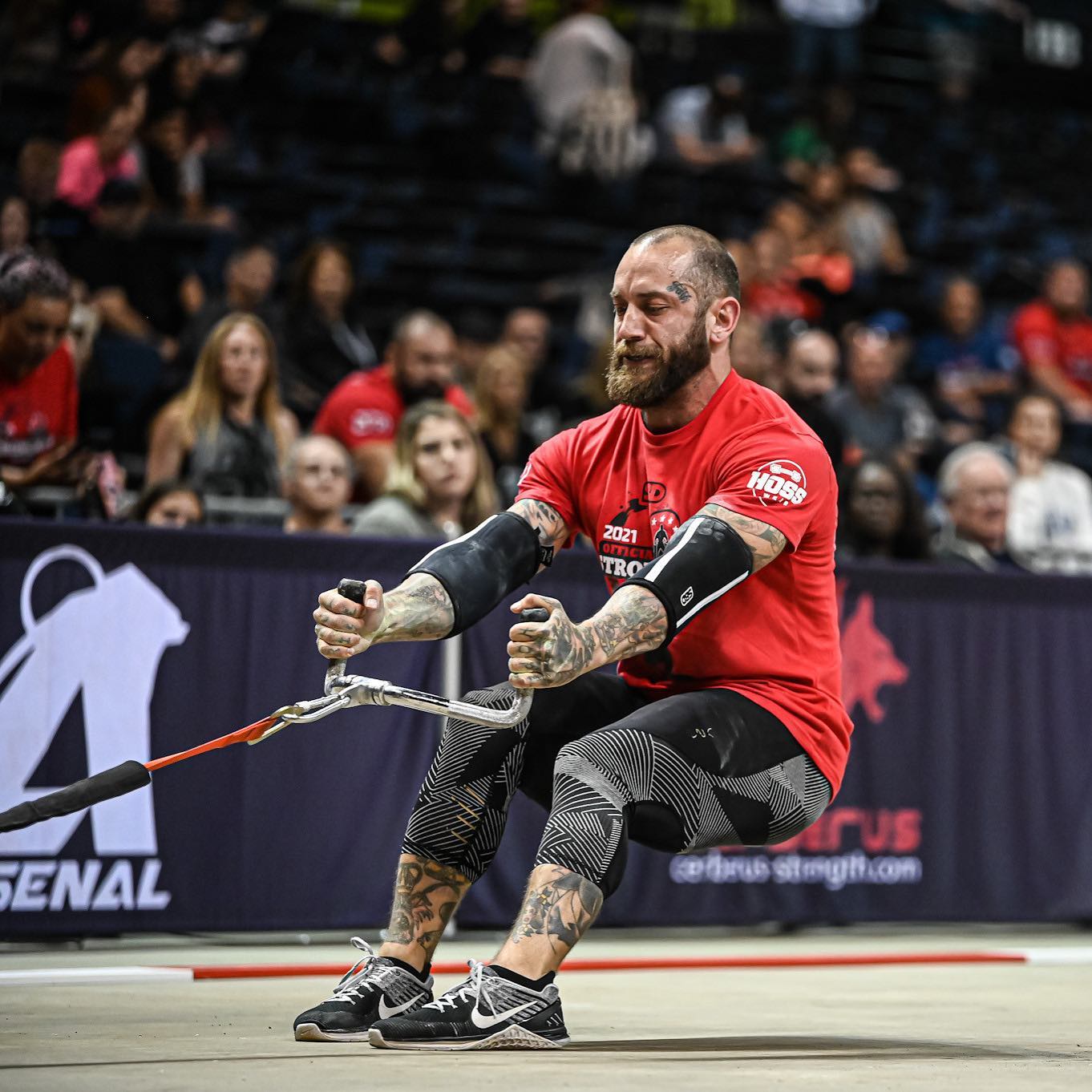
By Cody Abell (aka @strongest_tattooer)
I began competing in strongman in August 2016 and quickly became known for winning medleys, especially front carries. While some of that came from a natural ability, a lot has to do with how I train for – and coach – medleys. Here I’ll lay out some key elements to consider when programming medleys for your clients or yourself.
One of the key factors in medleys are the transitions; however, for some reason it’s one of the
most overlooked aspects. When I say transitions I don’t mean the “rehearsal” aspect of picking your approach and pick patterns for objects but rather, the literal transitions between objects and starting lines.
There are a few factors that play into this.
The first is simply fitness/conditioning, i.e. can your athlete physically handle repeated sprints after weighted carries and sprints done at near max effort? Or even more basically, can your athlete effectively sprint? Start by working on gait and cadence to improve sprint mechanics. Then practice accelerating into the sprint (building momentum and force later into the run).
Now, let’s assume your athlete is in good condition. (Because you program quality conditioning for your athletes year round, right? RIGHT?!?!) Your athlete’s lungs and heart can withstand the 25-60 seconds of high output. Programming can then focus on forced acceleration and basic sprinting drills. This is where I like to incorporate hill springs, sled pushes, and 5-10-15 drills.
Here are some quick examples and how to periodize those movements (assuming the client has no background in track):
Hill sprints are exactly what they sound like. Pick a hill and decide this is the hill you will get better at. The incline of hills helps with hamstring usage and just makes running feel harder and more like lifting effort rather than a Sunday stroll.
Assuming your athlete sticks to rest times and isn’t a g*ddamn liar, 8-12 hill sprints with periodized work intervals and set rest is a go-to. For example:
- Week 1: 10 Hill Sprints of 7 Seconds, Rest 2 Minutes
- Week 2: 10 Hill Sprints of 10 Seconds, Rest 2 minutes
- Keep building on this pattern, adding work each week
Sled pushes are very similar to hill sprints and can be treated as such, programming the athlete to work for set intervals of time and increasing that time week to week. I recommend keeping loads light for a few weeks and making sure that points of performance are improved or maintained before adding complexity or intensity.
Finally, my favorite: The 5-10-15 Agility Drill.
Much has been said about “football” camps and “agility” drills, but let’s just look at what we want to practice: Rapid Change Of Direction, Repeated Sprinting, Forced Acceleration.
Similar to the other 2 movements, some basic progressions are in order. With the 5-10-15s, I usually make it much more autoregulated. For example, 10-12 “sets” of this agility drill with each set increasing in intensity and ending so that the last 2-3 are all-out efforts.
The 5-10-15 drill is honestly my favorite; however, given the rapid change of direction I would do a few weeks of sled push or hill sprints first.
[PUT A BOW ON IT, ABELL]
So you had your athlete do some hill sprints and sled pushes and a few weeks of agility drills. Now… make it make sense.
It literally is as simple as this: add in extra shuttle runs to medley/moving pieces. Have the athlete set up on the opposite side from the carry implements and finish the medley with an unloaded shuttle run.
For example: shuttle run, front carry, shuttle run, front carry, sprint back to finish.
Medley transitions aren’t sexy. It’s largely pretty boring. At the end of the day, this is one of those aspects of strongman that is almost exclusively based on the effort the athlete puts in. No matter how strategically you program, if the athlete wants to get better, they have to put in the effort.
As someone who has podiumed at international contests and year after year bangs it out with the greatest athletes in the world, I can tell you that these small things are what matter. To this day, I spend at least 1-3x sessions a month outside my house on a hill doing sprints. Is it sexy? Do I look stupid to my neighbors? No idea. I’m busy tryin’ to win a world title, so it’s an easy choice for me.
What we’ve covered here is a simple and effective way to start improving medley times for your athletes. We can go way more in depth, but I need to keep my word count down so the Strongman.Training editing team (namely, Katie) doesn’t hate me.
If you want more in-depth conversations about this stuff, reach out to me. You can find me on Instagram at @strongest_tattooer or through my coaching group, Stronger Together (@the_stronger_together). Now go run some f’ing hills.
About Cody Abell
Cody has been competing in strongman since 2016, and consistently competes at the highest levels of the sport. He’s made multiple appearances at the Arnold Amateur World Championship (including podium finishes), Official Strongman Games World Championship, and Strongman Corporation National Championship, among others. He’s currently the head coach of Stronger Together, a team of high-level coaches providing strongman programming online. He’s also a full-time husband, dog dad, and tattoo artist.



